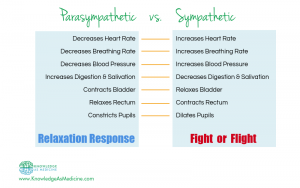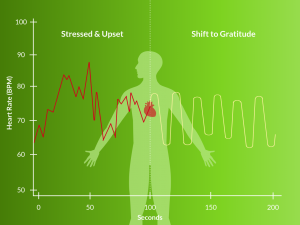Heart rate variability gives us a peek into the functioning of our autonomic nervous system. Our autonomic nervous system is made up of two balancing systems: the sympathetic nervous system known for its ‘fight-or-flight’ response, and the parasympathetic nervous system, known as the ‘rest-and-digest’ system. The sympathetic nervous system increases heart rate and the parasympathetic nervous system uses the vagus nerve to reduce heart rate.

Heart rate variability can show us real-time changes in the autonomic system in both healthy people and people with different health concerns like heart disease, anxiety, depression, inflammation and asthma. In fact, mothers may be vaguely familiar with this term “heart rate variability” when they give birth to their baby at the hospital. Commonly, during labor and delivery, a heart rate variability monitor is placed on the baby while inside the womb to monitor how well they are doing in the womb.
By definition, heart rate variability (HRV) is the variation of the time interval between two heartbeats. When you record your heart rate as 65 bpm (beats per minute), it doesn’t mean the heart is continuously beating 65 times every minute. At other times it maybe 69, or 62, or 71 due to the changing nature (or ‘variability’) of your heart rate.
HRV is an indicator of how well the systems of the body are working, and thereby an indicator of health. In a 2015 review article in Global Advances in Health and Medicine, Rollin McCraty, PhD of The Institute of HeartMath wrote, “An optimal level of HRV within an organism reflects healthy function and an inherent self-regulatory capacity, adaptability, or resilience.” This resilience and adaptability are signs of a stronger constitution and overall health.
HRV is really a balancing act, while greater variability is the signal for health, it is important to know that too much variability can lead to heart arrhythmias. Likewise, too little variability is a sign of chronic stress or lower regulation control within the body. The speed of the heart rate effects variability. When the heart beats faster there is less time in between heartbeats for variability so HRV is lower. Slower heart rates provide more time in between beats and HRV can increase.

Anything that affects our autonomic nervous system has an effect on HRV. What affects the autonomic nervous system? Our stress level, including our thoughts. Also, health-promoting activities, like physical exercise and breathing exercises, impact the autonomic nervous system in a health promoting way. Stress can be a physical phenomenon, such as needing to do more activity, but it can also be related to emotional stress such as anger, worry or frustration. These emotionally stressful situations can create irregular, uneven or erratic patterning in our heart rate variability. This irregular pattern indicates that both aspects of the autonomic nervous system — the parasympathetic and sympathetic branches — are not balancing each other as well as they could.
The HeartMath Institute describes this like “driving a car with one foot on the gas pedal (the sympathetic nervous system) and the other on the brake (the parasympathetic nervous system) at the same time – this creates a jerky ride, burns more gas, and isn’t great for your car, either!” A healthy HRV pattern is smooth and seen when we experience more positive emotions like joy, contentment, love, or gratitude. In this smooth state, the two branches of the autonomic nervous system are working with each other optimally.
We can learn to nudge our HRV into a healthier pattern with lifestyle choices and social interactions. For example, the hormone oxytocin increases your healthy HRV. Several studies have shown that oxytocin levels increase naturally during a massage, warm shower, cuddling a pet, and hugging. Oxytocin also increases your parasympathetic/sympathetic control.
Smooth, slow and continuous breathing patterns can optimize your HRV. Inhalation speeds up your heart rate, and exhalation slows your heart rate. HRV is increased in healthy people by slow, deep breathing. Deep breathing with rosary prayer, Zen meditation and yogic mantra meditation increases HRV. Breath rates of 8-10 breaths per minute show positive effects on HRV.
The reason positive emotions or positive thoughts have a healthy effect on heart rate variability is the heart-brain connection. Research studies show that low activity of the parasympathetic nervous system leads to lower heart rate variability, and this has been linked to panic, stress, worry and anxiety. Other studies have noted that low heart rate variability reduces our ability to self-regulate our thoughts, which can impair your mood.
Healthy heart rate variability improves the executive function of the brain by reducing painful memories or disturbing thoughts. This is a very powerful tool for people suffering from trauma — these conditions often shut down the executive centers of the brain, like the prefrontal cortex, due to prolonged stress or threat. This can lead to social isolation and hypervigilance.
Techniques that improve HRV are being used to treat hypertension, prehypertension, post-traumatic stress disorder in combat veterans, depression, anxiety, migraine headaches and neck pain. Freeze-Frame stress management from the Institute of HeartMath has been studied in elderly patients with congestive heart failure. Exercise can increase HRV in people with heart diseases and diabetes. People are incorporating HRV strategies into behavioral approaches to improve health care costs, self-regulation and work place stress. HRV tools have been studied in resiliency training for pilots, correctional officers and police departments.
Here are 5 ways to help increase your heart rate variability:
- Go for a walk in nature.
- Take a deep breath; repeat.
- Get a massage or self-massage your hands and feet.
- Start a gratitude journal.
- Get flexible with some yoga.
For more HRV information check out https://www.heartmath.com




